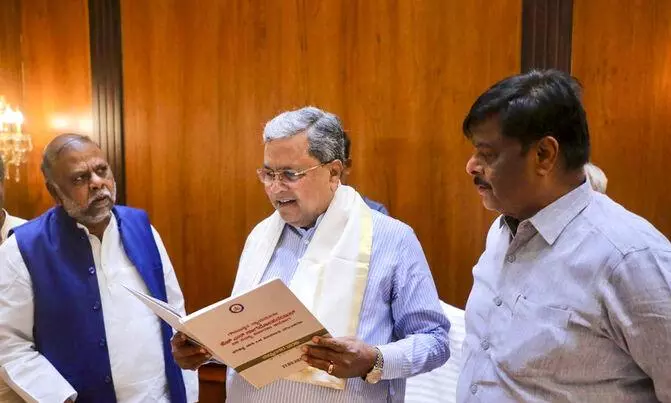
Despite decades of struggle, internal quota a distant dream for Karnataka's Dalits
For over 30 years, consecutive governments have formed new commissions and ordered surveys. Yet, after every report, there has been no implementation

The issue of internal reservation within the Scheduled Castes has remained a complicated and unresolved matter in Karnataka for decades.
A three-decade-long struggle has yet to reach a logical conclusion. Intensified protests by Dalit communities prompted the Congress-JD(S) coalition government in 2005 to form a commission under Justice AG Sadashiva. In 2012, the commission submitted its final report to then chief minister Sadananda Gowda, recommending quota allocation for Scheduled Caste (SC) sub-groups. However, successive governments have used the report as a political tool during elections rather than taking concrete steps towards implementation.
‘Left-hand’ community faces major hurdles
Even though the left-hand castes (Yedagai) within the SC category have fought hard for internal reservation, quota allocation continues to be a mirage for them. The BJP-led state government had approved the commission’s proposal and sent it to the Centre, but the process couldn’t move forward amid bureaucratic and political hurdles. Against this backdrop, it’s important to understand the population dynamics, Sadashiva Commission recommendations, Madhuswamy-led Cabinet subcommittee findings, and Justice Nagamohan Das Commission’s suggestions regarding the sub-categorisation of SCs.
Also Read: Karnataka govt to do survey of SCs to decide on internal reservation among them
Demand for quotas proportionate to population
As per the 2011 Census, Karnataka's total SC population stood at 96.66 lakh. However, according to the Sadashiva Commission, this number was 1,04,74,992. Among these, 7.29 lakh individuals had not declared their sub-caste, which has now become a challenge for sub-categorisation.
Of the 1.04 crore population, left-hand sub-castes like Madiga, Adi Dravida, Bambi, and others make up 33.25 lakh, while right-hand (Edagai) communities such as Holeya, Adi Karnataka, Chalavadi, and related castes comprise 30.93 lakh. The Adi Andhra, Adiya, Bhanda, Beda Jangama, Holey Dasari, and 42 other sub-castes constitute 4.5 lakh, and the Banjara, Bhovi, Koracha, Korama, and related groups form 22.84 lakh. There’s a growing demand to allocate quotas proportionate to these population sizes. However, sub-castes that have already benefitted from reservation oppose reclassification, citing their smaller numbers, which is causing further delays.
Changing demographics
According to the leaked information of the 2021 caste census (which has not yet been made public), SCs account for 19.5 per cent of Karnataka’s total population, followed by Muslims at 16 per cent. Lingayats and Vokkaligas make up 14 per cent and 11 per cent respectively. Among the Other Backward Classes (OBCs), Kurubas represent 7 per cent, with the overall OBC population accounting for 20 per cent. Given that the left-hand community constitutes a majority among the SCs, there are murmurs that the right-hand group is resisting internal reservation.
Also Read: Karnataka govt gives nod to give internal reservation among SCs
For over thirty years, Dalit groups have agitated for internal reservation. Each change in government has seen the formation of new commissions and surveys. Yet, after every report, excuses are made to shelve the findings, say activists. According to Chandru Tarahunase from the Internal Reservation Struggle Committee, these reports are revived only during election seasons for political gains.
Sadashiva Commission’s recommendations
The Sadashiva Commission had recommended internal reservation within SCs: six per cent for the left-hand untouchable communities, five per cent for the right-hand group, three per cent for touchable castes within SCs, and one per cent for sub-castes not included in any of the above three categories.
Despite gaining political traction during the 2013 and 2018 elections, these recommendations were never implemented. Instead, the issue became a deciding factor in changing governments.
Also Read: Internal quota for SCs: Karnataka CM to discuss with legal experts
Nagamohan Das Commission’s recommendations
Following state-wide protests demanding increased SC/ST quotas, the then-BJP government formed a new commission under Justice Nagamohan Das. After extensive study, it recommended increasing SC reservation from 15 per cent to 17 per cent, and ST reservation from three per cent to seven per cent.
In 2023, the Basavaraj Bommai-led government implemented these recommendations. Simultaneously, a Cabinet sub-committee was formed under then law minister JC Madhuswamy to review the Sadashiva Commission report.
Cabinet sub-committee’s proposals
The sub-committee led by Madhuswamy recommended the following based on population data:
· 5.5 per cent for left-hand groups like Madiga, Adi Dravida, Bambi, etc.
· 5.5 per cent for right-hand groups like Holeya, Adi Karnataka, Chalavadi, etc.
· 4 per cent for ‘touchable’ castes like Banjara, Bhovi, Koracha, and Korama.
· 1 per cent each for nomadic/semi-nomadic groups and other micro-SC communities.
Based on this, the state government decided to recommend the implementation of the Sadashiva report to the Centre.
Also Read: INDIA bloc divided on SC ruling on Dalit sub-quotas, but hails 'vindication' of caste census
Supreme Court ruling brings new hope
On August 1, 2024, the Supreme Court’s constitutional bench delivered a historic verdict supporting internal reservation.
The apex court ruled that state governments have the authority to sub-categorise SCs. It observed that reservation should be allocated to sub-castes in proportion to their population, especially for those with either no or inadequate representation in education and government jobs. However, after a regime change post-elections in Karnataka, implementation of the internal reservation report was once again put on hold.
Nagamohan Das Commission reconstituted
With both left-hand and right-hand SC sub-groups agreeing on the need for internal reservation and empirical data, the Congress-led state government reconstituted the Nagamohan Das Commission.
After two months of study, the commission recently submitted an interim report with four key recommendations.
One of its major proposals – approved by the Cabinet – was to conduct a new survey for the scientific classification of SC sub-castes. The data collection is to be completed within two months.
Also read: The tedious lightness of quota reform

